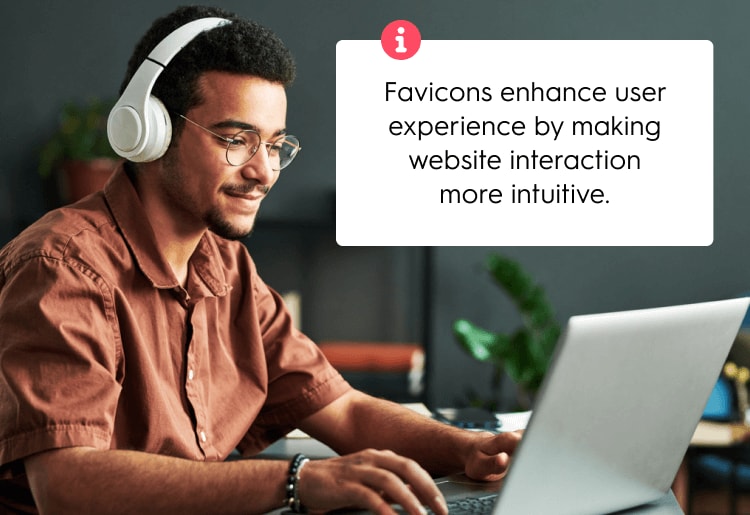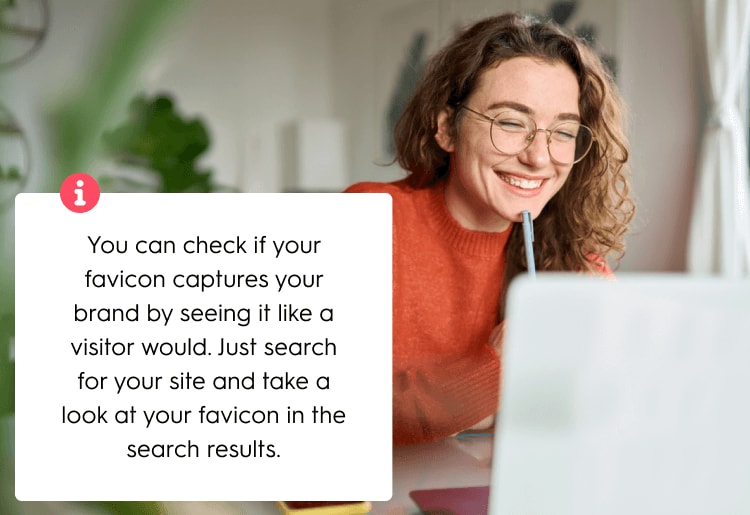Favicons are visual anchors that help users identify and return to your website. Often overlooked, these icons hold more value than many people realize, particularly if you want to increase your website views. But how do you create a distinct and memorable online identity?
I'm a professional website developer skilled in site design, and I'll show you how a small graphic can enhance your website's user experience and brand perception. With the right approach and tools, including versatile website builders, designing an effective favicon can become one of the ways to grow your business online.
» Time for a fresh web look? Ask yourself these questions before rebranding your website.
What Is a Favicon and Why Is It Important for Websites?
A favicon, short for "Favorite Icon," is a tiny, square image linked to a website or web page. You'll see it in the address bar, browser tabs, and one or two other places. They serve as a simple yet effective tool for website identification and navigation.
Favicons were initially used in browser bookmarks. Their use has since expanded to become a standard feature in web browsing.
Favicons enhance user experience by making website interaction more intuitive. For instance, instead of searching for a site, you can pin it to your browser for quick access instead of searching for the site.
They also signify professionalism, helping establish a brand's identity. For example, for easy recognition, Google uses the same colors across all their favicons. These are the things you need to think about before building your website.

Favicon Standardization
Although there are few strict standards, favicon common best practices are advisable for optimal performance across different browsers:
- Stick to square-shaped 16x16, 32x32, or 48x48 pixel size for clear visibility.
- Use ICO favicon format for broader compatibility.
The Branding Impact of a Well-Designed Favicon
A well-designed favicon is a statement showing your attention to detail. It contributes to continuous brand identity and trust. For example, Netflix's simple yet recognizable design is a bold red “N” on a black background. It's consistent with the brand design, helping viewers identify the site easily.
Importance of Favicons in SEO
Favicons indirectly influence your search engine optimization (SEO) rankings through enhanced user experience. This means they encourage engagement that can positively affect your website's SEO.
Familiar favicons are more recognizable, so users are more likely to trust, look for, and navigate to those sites. Frequent user engagement and site recognition are elements considered by search engines.

Tips for Designing a Favicon
When you create your favicon, remember that you're designing far more than just a tiny picture. Keep the following in mind:
- Concise representation: A favicon should be a simple, recognizable image representing your brand identity. For instance, the favicon for Twitter was a blue bird with an open mouth to tweet.
- Colors and aesthetics: These help to reinforce your brand’s visual appeal and make it easier for users to recognize you. For example, the favicon for Coca-Cola features the brand’s signature red and white colors with the curly font.
- Impact on user memory: It should be easy to remember and recognize, even when displayed in a small size. For instance, the favicon for Amazon is a simple “A” with an arrow.
- Optimizing for different platforms: This will ensure it displays correctly on all devices. Create multiple versions in various sizes and formats for broader visibility.
» Color your website right! Use these tips to choose the perfect website color scheme.
Implementing a Favicon in HTML
To add a favicon using HTML:
- Insert a "<link>" element in the "<head>" section of your HTML code.
- Link the href (hypertext reference attribute) to the location of your favicon file.
Here is an example code:
<head>
<link rel="icon" href="favicon.png" type="image/png">
</head>
Favicon Design for Smaller Brands
Smaller brands can also create impactful favicons that direct communities can recall easily. For example, Mid Journey, known for its AI expertise, has a recognizable favicon. The simple outline of a sailing boat stands out to web designers and content creators.
» New to coding? Follow these steps for beginners to build a website with HTML.
Tools for Favicon Creation
You can use various tools for creating a favicon:
- Traditional software: Design software like Adobe Photoshop provides a range of tools and features that you can use to create a favicon design.
- AI-based websites: Wix's Wix Logo Maker uses artificial intelligence to generate a favicon from an image or text.
- Online platforms: Some platforms that provide an easy-to-use interface for designing your favicon are Squarespace and IONOS. They offer a range of templates and assist with how to find your brand voice.
Adding and Testing Your Favicon
To add a favicon, upload the file to your website through the site settings. Ask your friends or colleagues to thoroughly check its appearance across all the displays you expect it to appear on. Use incognito mode to prevent caching irregularities.
You can also check if your favicon really captures your brand's vibe by seeing it like a visitor would. Just search for your site and take a look at your favicon in the search results. If you're satisfied with how your favicon visualizes your brand essence, you have successfully implemented it for users to recognize.

Favicon Power: A Small Symbol With Big Impact
A well-designed favicon is more than just a tiny, square graphic; it's a key component in the digital identity of your online website. Pay attention to the finer details to enhance brand recognition. These days, the benefits of having a small business website and a matching favicon are part and parcel of increasing sales.
Use the help of website builders like Jimdo and Jimdo alternatives to simplify creating and integrating your favicon. Though small, your new symbol is a crucial touchpoint in your visitors' digital journey.
» Setting up shop online? Consider these factors when designing an e-commerce homepage.

